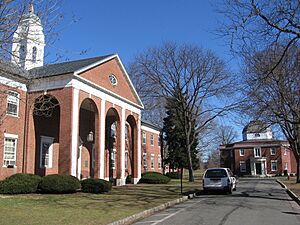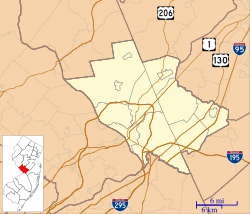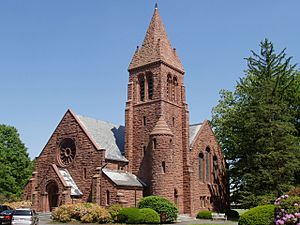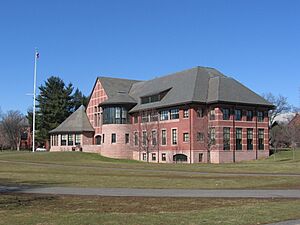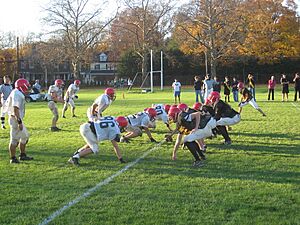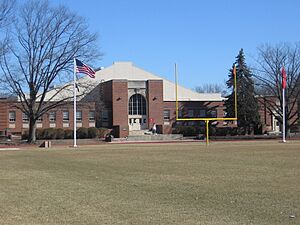Lawrenceville School facts for kids
Quick facts for kids The Lawrenceville School |
|
|---|---|
 |
|
| Address | |
|
2500 Main St, Lawrenceville, NJ 08648
, , United States
|
|
| Coordinates | 40°17′39″N 74°43′30″W / 40.29414°N 74.72494°W |
| Information | |
| Type | Private, independent, day and boarding, college-preparatory |
| Motto | Virtus Semper Viridis ("Virtue Always Green") |
| Established | 1810 |
| CEEB code | 310680 |
| NCES School ID | 00869171 |
| President | Michael S. Chae |
| Head of school | Stephen S. Murray |
| Faculty | 117.1 FTEs |
| Gender | Coeducational |
| Enrollment | 818 (as of 2021–22) |
| Student to teacher ratio | 7:1 |
| Campus | 700 acres (2.8 km2) |
| Color(s) | Red and black |
| Athletics conference | Mid-Atlantic Prep League New Jersey Independent Schools Athletic Association |
| Sports | Yes |
| Mascot | Larrie the Bulldog |
| Nickname | Big Red |
| Rival | The Hill School |
| Accreditation | Middle States |
| Endowment | $632.9 million (as of July 22, 2021) |
| Tuition | $79,500 Boarding $65,420 Day (2024-25) |
| Affiliations | NJAIS ESA TSAO |
The Lawrenceville School is a private school in Lawrenceville, New Jersey. It's a place where students live and learn, getting ready for college. Both boys and girls attend, either living at the school (boarding) or coming for the day. Lawrenceville is part of special groups like the Eight Schools Association.
Contents
A Look at Lawrenceville's History
How the School Started
The Lawrenceville School began in 1810. It was first called the Maidenhead Academy. A minister named Isaac Van Arsdale Brown started it. It's one of the oldest schools in the United States that prepares students for college. Over the years, it had other names, like Lawrenceville Classical and Commercial High School.
A New Beginning in the 1800s
In 1883, the school got a big boost from the John Cleve Green Foundation. John Cleve Green was a successful businessman who had been a student at the school when he was young. He left a lot of his money to help good causes.
The people in charge of Green's money wanted to make Lawrenceville a top college-prep school. They hired James Cameron Mackenzie to lead the school. He studied schools in the United Kingdom and brought new ideas, like the "house system." This system created smaller living groups for students, making the school feel more like home.
The school also got a new campus designed by famous people like Frederick Law Olmsted. This campus is now a special historic place in the U.S.
Growing Stronger and More Diverse
The changes in 1883 made Lawrenceville very popular. Many students went on to Princeton University. Lawrenceville became a model for other boarding schools that started around that time.
In the 1930s, Lawrenceville adopted the Harkness method. This is a way of teaching where students sit around a table and discuss topics together. It helps everyone share their ideas.
In 1964, Lawrenceville welcomed its first African-American students. This was an important step for the school. In 2024, the school honored these first students by renaming a part of the gym after them. Today, many students from different backgrounds attend Lawrenceville.
Girls started attending Lawrenceville in 1987. Since then, girls have taken on important leadership roles, like being the first female student body president and the first female head of school.
Lawrenceville Today
In the 2000s, Lawrenceville focused on being a school that helps all students succeed, not just those from wealthy families. The school receives many applications each year.
In 2010, Lawrenceville even set a world record for the largest custard pie fight!
Leaders of the School
Many people have led Lawrenceville School since it began. Here are some of them:
- Isaac Van Arsdale Brown, 1810–1834
- Samuel McClintock Hamill, 1837–1883
- James Cameron Mackenzie, 1883–1899
- Allan Vanderhoef Heely, 1934–1959
- Bruce McClellan, 1959–1986
- Elizabeth Anne Duffy, 2003–2015
- Stephen Sheals Murray, 2015–present
Paying for School
Lawrenceville School has a tuition fee, which is the cost to attend. For the 2024-25 school year, it costs $79,500 for students who live at the school and $65,420 for day students.
However, Lawrenceville also offers financial aid. This means they help families pay for tuition if they need it. The school tries to cover 100% of a family's proven financial need.
In the 2023-24 school year, about one-third of students received financial aid. Some families with lower incomes paid very little, while others with higher incomes paid more.
School Money and Gifts
Lawrenceville has a large amount of money called an financial endowment. This money helps the school operate and grow. In 2021, the endowment was over $632 million.
The school also receives big gifts from generous donors. In 2017, Alibaba founder Joseph C. Tsai and his wife Clara Wu gave the largest gift in the school's history.
The School Campus
|
Lawrenceville School
|
|
|
U.S. Historic district
Contributing property |
|
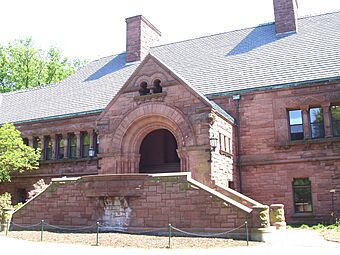
Woods Memorial Hall at the Lawrenceville School
|
|
| Location | Main Street, Lawrenceville, New Jersey |
|---|---|
| Area | 17.74 acres (7.18 ha) |
| Architect | Peabody & Stearns; Frederick Law Olmsted |
| Architectural style | Queen Anne, Romanesque |
| Part of | Lawrence Township Historic District (ID72000799) |
| NRHP reference No. | 86000158 |
| Significant dates | |
| Added to NRHP | February 24, 1986 |
| Designated NHLD | February 24, 1986 |
| Designated CP | September 14, 1972 |
Lawrenceville has its own large campus, separate from the town. It's about a 15-minute drive from Princeton, New Jersey.
Historic Campus Buildings
The oldest part of Lawrenceville's campus is a National Historic Landmark. This means it's a very important historic place. The campus was designed by Frederick Law Olmsted and the firm Peabody & Stearns. They created beautiful buildings like Memorial Hall. The campus covers about 700 acres today.
Living at School: The House System
Lawrenceville uses a "house system" for students who live there. This is like having smaller communities within the school. Students live in different houses depending on their grade level. Teachers also live in the houses to support the students.
There are houses for freshmen, sophomores, juniors, and seniors. Many of these houses are part of the historic campus. New houses have also been built over the years.
School Facilities
Lawrenceville has 38 main buildings. The Bunn Library can hold 100,000 books!
The school also has many sports facilities. These include 18 athletic fields, a golf course, tennis courts, tracks, a hockey arena, and a ropes course. There's even access to a boathouse for rowing. A new building called the Tsai Commons and Field House opened in 2024. It has a new dining hall and more athletic spaces.
Lawrenceville also uses a solar farm for its energy. This helps the school be more environmentally friendly. The school also has a working farm called the Big Red Farm. It has greenhouses, farmland, and animals like sheep, chickens, and pigs.
School Connections
Lawrenceville is part of the Eight Schools Association and the Ten Schools Admissions Organization. These are groups of leading schools in the U.S.
The school also has a connection with The Island School in The Bahamas. Some Lawrenceville students can go there for a semester to study.
Sports and Athletics
Lawrenceville's sports teams are called the Big Red. They compete in the Mid-Atlantic Prep League. Students can play many different sports, including baseball, basketball, soccer, swimming, and more. There are also fun intramural sports like Ultimate Disc and flag football.
Rivalry with The Hill School
Lawrenceville has a big sports rivalry with The Hill School in Pennsylvania. They have one of the oldest high school football rivalries in the country, going back to 1887! They celebrate this rivalry during "Hill Weekend" each November.
Recent Sports Successes
Lawrenceville teams have won many championships.
- In 2015, the boys' varsity crew team won their league championship and placed high in national races.
- The boys' and girls' varsity track and field teams have had many undefeated seasons and won state championships.
- The girls' varsity field hockey team won several state championships in a row in the 2000s.
- The boys' varsity squash team won the National Championship three years in a row in the mid-2000s.
- The boys' varsity baseball team won state championships in 2006 and 2010.
- The boys' varsity lacrosse team won the Prep Nationals championship three years in a row, from 2023 to 2025.
Famous People Who Attended Lawrenceville
Many notable people have gone to Lawrenceville School. These include writers like James Merrill and Frederick Buechner, musicians like Huey Lewis and Dierks Bentley, and athletes like Joakim Noah.
Notable Teachers at Lawrenceville
Some famous people have also taught at Lawrenceville, including:
- Thornton Wilder (1897–1975), a writer who won the Pulitzer Prize three times.


